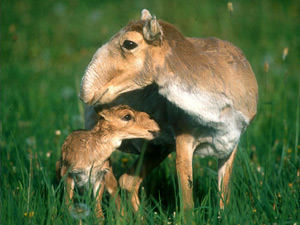Death on the Steppes: Mystery Disease Kills Saigas
 Death on the Steppes: Mystery Disease Kills Saigas
Death on the Steppes: Mystery Disease Kills Saigas
Before the end of the last Ice Age, saigas roamed by the millions in a range stretching from England to Siberia, even into Alaska. Eventually they moved to the steppes of Central Asia, where they continued to thrive — until the 20th century, when these strange-looking antelopes began flirting with extinction.
Hunted for its horns, 95 percent of the population disappeared, and the saiga was declared critically endangered.
After the implementation of strict antipoaching measures, the population recovered. “It was a big success story,” said Eleanor J. Milner-Gulland, the chairwoman of the Saiga Conservation Alliance.

Now that success is in jeopardy. Last month, a mysterious disease swept through the remaining saiga herds, littering the steppes with carcasses. The so-called die-off claimed more than a third of the world’s population in just weeks.
An international team of wildlife biologists is now examining tissues taken from dead saigas, hoping to figure out what killed them. Whatever it is, it has the potential to undo years of conservation efforts, further endangering the species.
“Once we know what’s causing it, then we need to think very hard about how to avoid it in the future,” said Aline Kühl-Stenzel, the terrestrial species coordinator of the Convention on the Conservation of Migratory Species of Wild Animals.
Saigas are remarkable creatures. In the spring, they migrate across the steppes by the thousands, the females pausing just long enough to give birth, usually to twin calves. Saigas can travel more than 50 miles a day on their migrations, and can run more than 40 miles per hour.
Naturalists are quick to note their improbable, cartoonish faces, anchored by enormous noses somewhat resembling elephant trunks.
“It’s a remarkable structure, really,” said Dr. Kühl-Stenzel, who has studied saigas since 2003. “In the rutting season, the male’s nose swells even more, and then they shake their heads and it makes a squishy sound.”
Females may be attracted to the fleshy noses of males. But scientists also suspect these noses protect saigas from dust rising up from the dry ground.
“To some extent, the nose is a filter,” she said. “But it probably also cools the air in the summer, and in winter, it probably heats the air, as well.”
From time to time, saigas have faced widespread die-offs. The last major one occurred in 2010, when 12,000 animals died. The causes are still uncertain, because biologists did not reach the animals until long after they expired.
“There’s no data at all, and so people go on speculating,” said Richard A. Kock, an expert on wildlife disease at the Royal Veterinary College in London.
The die-off is now 10 times bigger than the 2010 event. And because the saiga population was at a precariously low level, the die-off has claimed an astronomical proportion of the species, from one-third to perhaps a half.
“The scale is absolutely unprecedented,” Dr. Kühl-Stenzel said.
Dr. Berger said that it was urgent to figure out what killed the saigas to ensure long-term survival of the species: “We’re not going to get ahead of the curve if we don’t understand what’s doing this.”













